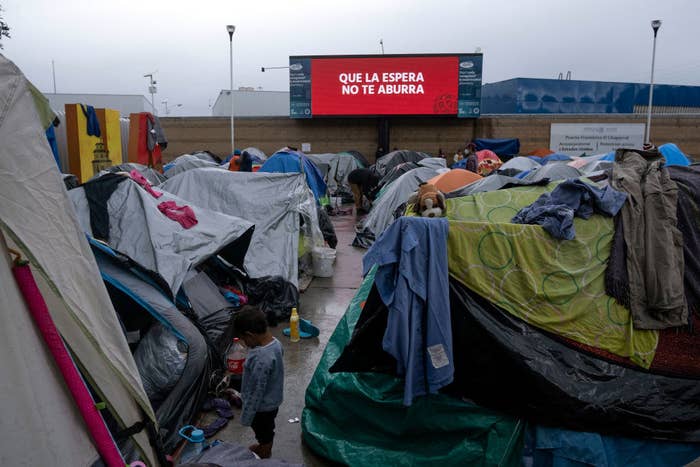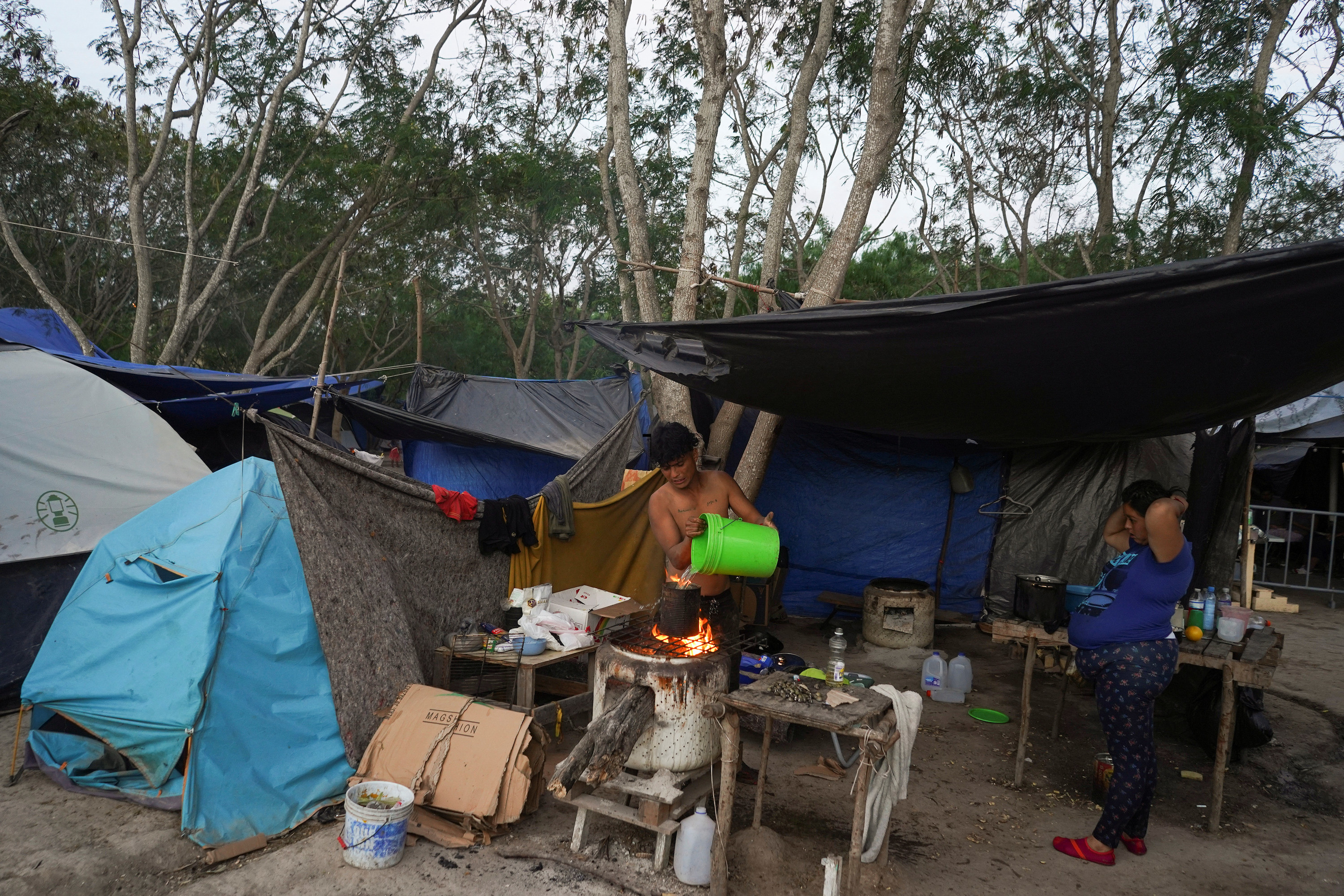
Immigration officials on Monday said they've started to wind down a Trump-era program that forced thousands of immigrants to wait in Mexico while their US immigration cases were completed.
In a statement, the Department of Homeland Security said it stopped enrolling new people into the Remain in Mexico program. Immigrants and asylum-seekers who are currently enrolled in the program and in Mexico would be taken out when they show up at the border for their next court date, allowing them to continue their cases from within the US.
Remain in Mexico “has endemic flaws, imposes unjustifiable human costs, and pulls resources and personnel away from other priority efforts to secure our border,” DHS said.
This is the second time the Biden administration has started to end the policy. Last year, District Court Judge Matthew J. Kacsmaryk issued an injunction that required the Biden administration to restart Remain in Mexico. DHS's announcement came hours after Kacsmaryk vacated his injunction after the Supreme Court ruled in June that the Biden administration could rescind the much-disputed policy and sent the case back to his court.
After the policy was put in place in January 2019 by then-president Donald Trump, more than 70,000 immigrants and asylum-seekers were sent back to Mexico under what’s officially called the Migrant Protection Protocols. The policy resulted in forcing thousands of immigrants to wait for their day in a US court in dangerous Mexican border cities, where they have little access to legal aid and live with the constant threat of violence from cartels.
Immigrants were often left with nowhere to go but the streets, and in one Mexican city, hundreds of people lived in a squalid camp for months, if not more than a year, in what became a symbol for the Trump administration’s Remain in Mexico policy. Human rights advocates tracked hundreds of cases of returned immigrants being kidnapped, raped, and tortured while the US government forced them to wait there.
Shortly after taking office, President Joe Biden stopped enrolling people into the program and later started processing some of the people put in Remain in Mexico into the US, where they will continue their immigration cases. In June, Biden fulfilled a campaign promise when the Department of Homeland Security published a memo terminating the policy.

In April 2021, Texas and Missouri sued the Biden administration, arguing it had violated the Immigration and Nationality Act and the Administrative Procedure Act. A US District Court agreed with the two states and said terminating MPP violated the INA because immigration law gives the government two options in what to do with undocumented immigrants, mandatory detention or returning them to a contiguous country like Mexico.
At the center of the court's ruling were two provisions of immigration law. The first is a law stating that an immigrant "shall" be detained pending the conclusion of their case. However, the US has lacked the resources to detain every undocumented immigrant in the country. Immigration law also says the government "may" return immigrants and asylum-seekers back to the country they came from while their cases are pending.
Kacsmaryk ruled, and the 5th Circuit later agreed, that because the law says the government "shall" detain all undocumented immigrants but is unable to, the US was required to return all the ones it can't detain to Mexico. The ruling also required the Biden administration to restart the Remain in Mexico program.
After being denied a request to stay the order by the 5th Circuit, the Biden administration asked the Supreme Court to put the ruling on hold while it appealed Kacsmaryk's order that the program be reinstated. But the Supreme Court also ruled against the request and said the administration "failed to show a likelihood of success on the claim that the memorandum rescinding the Migrant Protection Protocols was not arbitrary and capricious."

While it appealed the ruling, the Biden administration started preparing to relaunch Remain in Mexico and enrolled its first group of immigrants in December 2021.
The 5th Circuit also ruled against Biden’s efforts to end Remain in Mexico, which led to the case being taken up by the Supreme Court.
Ultimately, the Supreme Court disagreed with the 5th Circuit in a 5–4 ruling, in which the three liberal justices were joined by Justice Brett Kavanaugh and Chief Justice John Roberts. It was a major victory for the Biden administration, which has been thwarted by the courts in its attempts to end Trump-era immigration policies.
In the majority opinion written by Roberts, the justices found that because the INA states the US "may" return immigrants and asylum-seekers, the federal government has the discretion to decide whether to send them back to Mexico. The government continues to have this discretion even if another law states that the US "shall" detain undocumented immigrants, Roberts wrote.
Immigration law allows the government a third option on what to do with undocumented immigrants, which is to admit them into the US and release them while their cases are adjudicated, Roberts said.

In its ruling, the Supreme Court remanded the case to the lower courts, which must now decide whether Biden violated administrative law when it issued a second memo terminating Remain in Mexico.
In October, the DHS issued a second memo terminating Remain in Mexico after the lower courts said that the reasons it gave in its first memo were inadequate. The government was given the option of either providing more information about its decision or taking new separate action to terminate it.
The lower courts interpreted the second memo as being a more detailed explanation, but the Supreme Court disagreed and said it was a separate action. The Supreme Court remanded the case to the lower courts and said that given its ruling that it was a separate action, the District Court should consider whether the second memo violated the Administrative Procedure Act.

Since Remain in Mexico was relaunched in December, the Biden administration has enrolled more than 5,000 immigrants into the program. That number pales in comparison with the thousands of immigrants and asylum-seekers who have been quickly expelled to Mexico since March 2020 under a pandemic Trump-era policy — known as Title 42 — without the opportunity to seek protection. The US has expelled immigrants at the border under Title 42 more than 2.1 million times.
Like the Trump administration, Biden relied heavily on Title 42 at the border and quickly expelled immigrants and asylum-seekers to Mexico. Immigrant advocates were critical of Biden’s decision to continue Title 42 despite knowing that, like Remain in Mexico, the policy was also sending immigrants back to danger.
Eventually, the Biden administration announced plans to end Title 42 in May, but a judge blocked the government from winding it down. In his order, Judge Robert Summerhays ruled that Title 42 should remain in place while the 24 Republican-led states continued with their lawsuit challenging Biden’s efforts to end the policy.
